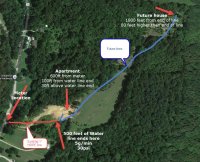lemahoney08
New Member
I have talked to numerous plumbers and engineers, all of which has non confident answers.
I am currently building a one bedroom apartment which is 75 ft in elevation higher than the city water meter and about 500 feet in distance from the meter. I have plans to build a normal size 3 bedroom house another 1200 feet further back from the road (1700 feet away from the meter) and 160 more feet of elevation (235ft higher than the tap) which would connect to the same line I am putting in now. The city water is a small community well so pressure carries. I would estimate 60lbs at the meter on a 3/4 inch meter.
I have heard everything from run 2" slip joint up the hill and bury a jet pump to push it when the pressure runs out, to run 1" HDPE to just before the apartment and let that fill a holding tank which I would then pump into the houses.
My question is, what is a good cost effective way to get water where I need it.
Is there a pump that I can bury inline which will boost the pressure in stages up the hill.
What size tank would I need in this case as I want enough that I don't run out, yet don't want it to get stagnant.
What size and type of pipe do I use. It is not flat ground, I will have to cross a creek and a driveway.
If going a tank route, is there something I can do with floats to stop it from overfilling, and stop pumping from it when empty to not burn up the pumps?
Does anyone have a system like this in place who can provide feedback on how well it works.
The picture is taken from where the apartment is located, towards the road where the meter is located to give some extra information
I am currently building a one bedroom apartment which is 75 ft in elevation higher than the city water meter and about 500 feet in distance from the meter. I have plans to build a normal size 3 bedroom house another 1200 feet further back from the road (1700 feet away from the meter) and 160 more feet of elevation (235ft higher than the tap) which would connect to the same line I am putting in now. The city water is a small community well so pressure carries. I would estimate 60lbs at the meter on a 3/4 inch meter.
I have heard everything from run 2" slip joint up the hill and bury a jet pump to push it when the pressure runs out, to run 1" HDPE to just before the apartment and let that fill a holding tank which I would then pump into the houses.
My question is, what is a good cost effective way to get water where I need it.
Is there a pump that I can bury inline which will boost the pressure in stages up the hill.
What size tank would I need in this case as I want enough that I don't run out, yet don't want it to get stagnant.
What size and type of pipe do I use. It is not flat ground, I will have to cross a creek and a driveway.
If going a tank route, is there something I can do with floats to stop it from overfilling, and stop pumping from it when empty to not burn up the pumps?
Does anyone have a system like this in place who can provide feedback on how well it works.
The picture is taken from where the apartment is located, towards the road where the meter is located to give some extra information



